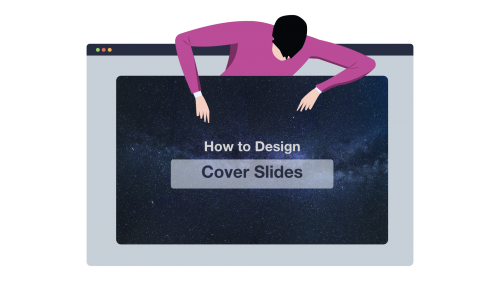

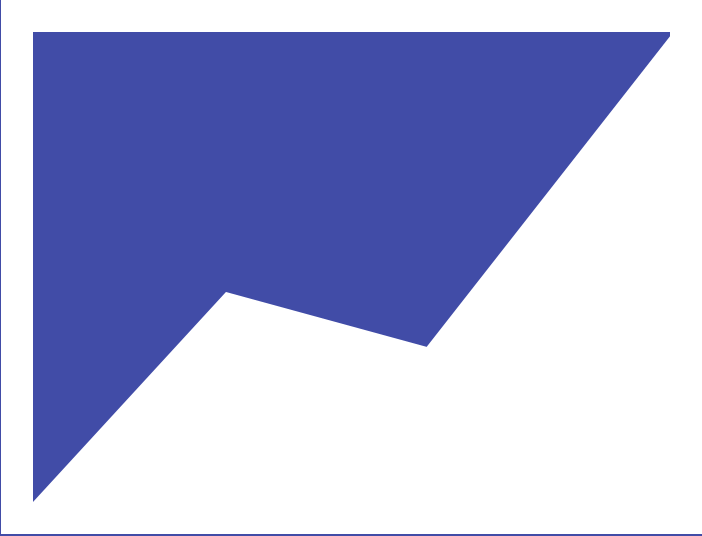
This is the best PowerPoint title slide tutorial on the Web. Period.
In fact, you’re going to learn a simple, 3-step process to designing gorgeous and professional presentation cover slides that get your point across. In 5 minutes top.
Let’s dive right in…
Anyone, including your grandma, should be able to understand what your PowerPoint title slide is going to be about.
Here’s a concrete example:
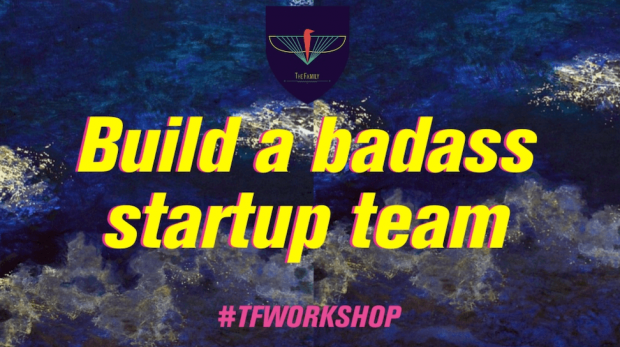
In this cover slide, we quickly understand that the presentation will be covering details (very likely tips) on how to build a successful team for your startup.
Every presentation title slide has 3 “ingredients”.
👉 The background (your visual, or the color you’ll be using in your background)
👉 The lay-out (where and how you position the different elements in the slide)
👉 The text (usually, a headline and a sub-headline that wrap up what the presentation is about)
The process we’re about to follow will address how to deal with each of these elements.
Welcome to Step 1 😀
Here, you basically have two options to chose from:
1) Using a plain color for your slide background (super easy)
2) Using a visual
As you’ve guessed, the first option is the quickest one. And it doesn’t require any brain work at all. So we’re going skip it and cover directly how to proceed with the second option.
If you want to design a cover slide that’ll grab people’s attention, you need to start with asking yourself this simple question:
What’s my presentation topic?
Answer using this formula:
My presentation is about [ X ]. So the topic is [ Y]
Here are a few examples:
My presentation is about [ our yearly financial report ]. So the topic is [ finance ].
My presentation is about [ power supply dynamics ]. So the topic is [ power supply / engineering ].
My presentation is about [ our client’s social media strategy ]. So the topic is [ social media / marketing ].
See where I’m going?
Now that you have a clear topic for your presentation, you’re going to associate that topic with specific keywords. The point here is to find out keywords we’ll be using as search terms when looking for visuals online.
Here are a few examples:
Topic: SEO services
Related elements: Computer (or web traffic, web page, graph)
Topic: Consulting firm business proposal
Related elements: office building (or business people, meeting, investors)
Now that you have a few keywords for your cover slide, you’re going to be looking for a relevant visual.
Pexels (my favorite’s, lots of visuals)
Burst (solid)
Gratisography (crisp, fun)
Death to the stock photo (a bit of everything)
Startup stock photos (genuine-looking)
Unsplash (nature related)
Little visuals (like Unsplash)
Pic jumbo (urban-related mostly)
First, check out the results.
Then, select one picture that closely relates to the identified keyword. If you’re struggling with choosing between various visuals, then ask a few colleagues which one they prefer and go for the most popular option.
✅ Search keywords that directly relate to your topic in order to find a relevant visual for your cover slide (e.g. finance -> “money”, “charts”, social media -> “phone”, “people”)
✅Download visuals in high resolution (this is especially important if you’re presenting on a screen).
✅ To save time in the future, create a folder on your desktop. Anytime you stumble upon a great visual, just add it to your folder (get more tips just like this one right here).
Now that you’ve found a visual that fits with your presentation topic, it’s time to decide which lay-out you will use to display the title of your presentation on your cover slide.
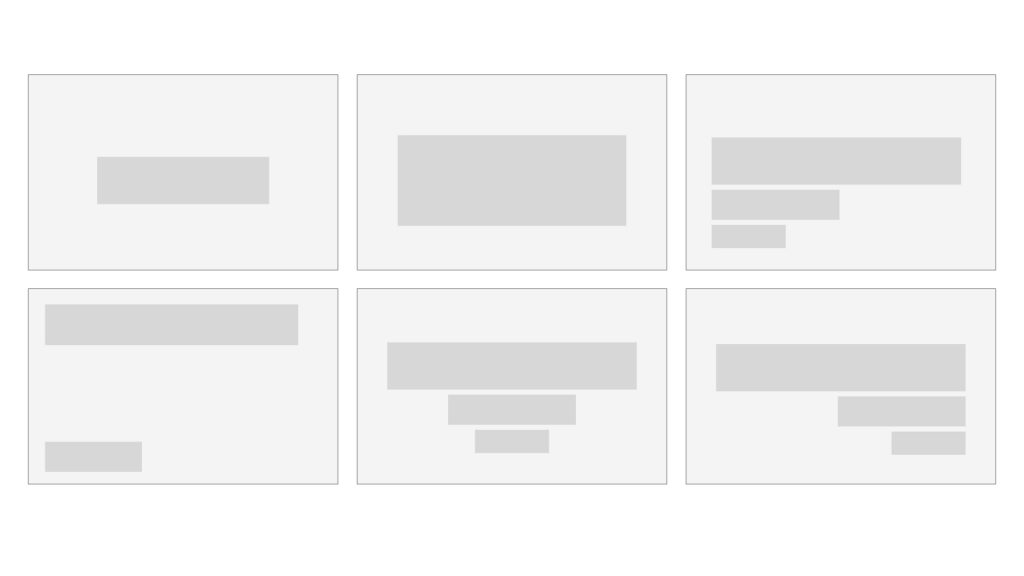
Here are various text placement options you can chose from:
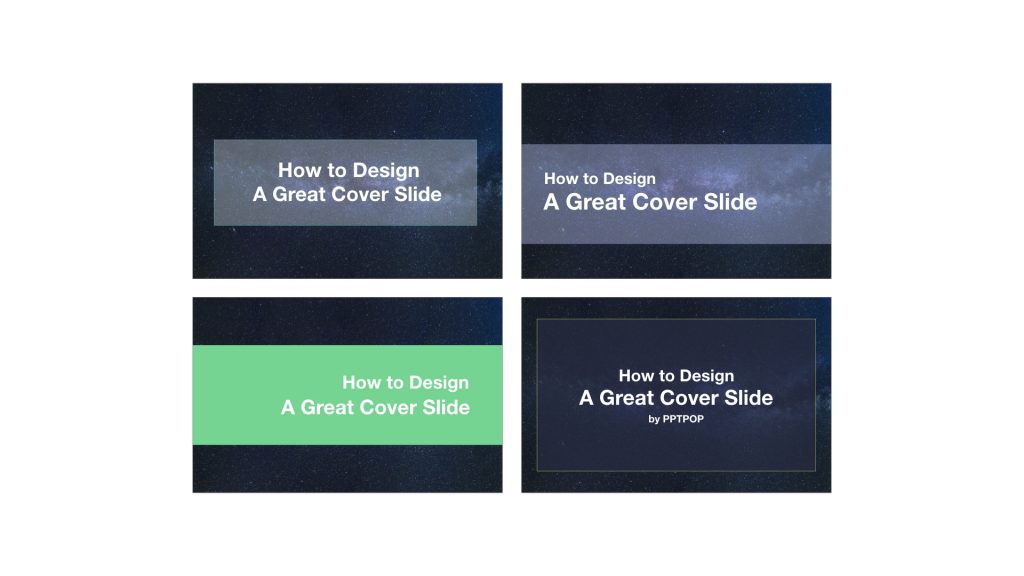
Here’s how it would look like with real examples:
There’s no right or wrong answer when it comes to deciding which lay out you’re going to use. I recommend you to make sure there’s the minimum amount of text possible on your cover slide for three reasons:
👉It’s easier to design a good looking introduction slide when there’s not too much text
👉No one want to be bothered by a wall of text straight off the bat
👉You need to be able to wrap up what your presentation is going to cover in a clear and concise way
Your title slide shouldn’t have more than a headline (that resumes the content of your deck in a sentence), a name (yours or the one of your company), and a logo or a date.
With that said, on top of choosing your lay-out, you’re going to have to chose whether you want your text to appear directly on top of your background or not. Here’s a simple rule you can follow:
⚠ For plain color backgrounds : add your text on top of the background or integrate it on top of a rectangle/rounded shape
⚠ For visual backgrounds : to make sure your text can easily be read by your audience, add a shape on which you will display your title text
Of course, you can select other shapes such as these ones:

You can also customize your text bar playing with both color and transparency.
Adding transparency allows people to see the whole visual behind. But use it with care: your first priority is to get readers to feel comfortable when looking at your slides.

Contrast is the king . Dark shape = light/flashy colors for the text. Light shape = dark colors for the text.